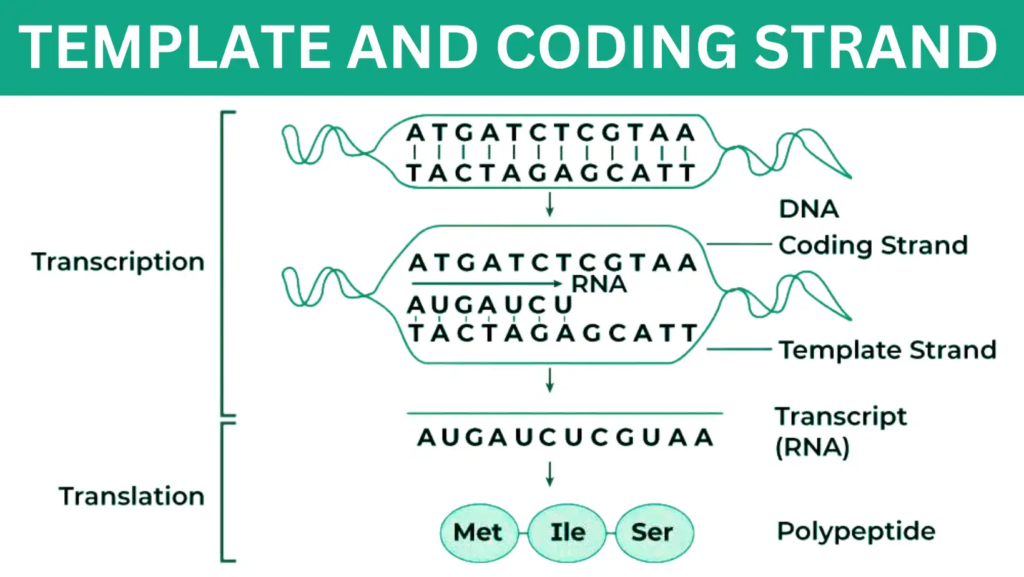DNA comprises two strands that coil around each other to form a double-helix structure. The template strand and the coding strand are the two known strands. Though they are part of the same DNA molecule, they have some key differences.
Overview of DNA Structure
Before delving into the specifics of template and coding strands, let’s briefly outline the structure of DNA. DNA, or deoxyribonucleic acid, is a double-stranded molecule comprising nucleotide units.
Each nucleotide comprises a sugar-phosphate backbone and a nitrogenous base—adenine (A), thymine (T), cytosine (C), or guanine (G).
The DNA molecule is organized into a double helix, where two strands run in opposite directions and are held together by hydrogen bonds between complementary base pairs (A-T and C-G). This structure forms the basis of genetic information transfer and inheritance.

What is the Template Strand?
- The template strand has alternative names, such as the minus strand or antisense strand.
- It provides the template or instructions to make mRNA during transcription.
- The template strand goes from 3′ to 5′. This implies interpreting from the 3′ terminus to the 5′ terminus.
- Its nucleotides are complementary to the coding strand and the newly made mRNA strand. For example, if the coding strand has an A, the template will have a T.
- It has anticodons, which are three nucleotide sequences that match the anticodon on tRNA during protein synthesis.
- The RNA polymerase binds to the template strand and reads it from 3′ to 5′ to make the mRNA.
What is the coding strand?
- The coding strand, also referred to as the plus or sense strand,
- The mRNA strand has the same sequence as it, except it replaces T with U.
- The coding strand goes from 5′ to 3′, contrary to the direction of the template strand.
- It contains codons, which are three nucleotide sequences that code for amino acids during protein synthesis.
- The RNA polymerase does not read the coding strand. It uses the template strand as a guide.
- The coding strand pairs up with the anticodons of tRNA during translation.
Comparison Chart – Template VS Coding Strand
| Property | Template Strand | Coding Strand |
|---|---|---|
| Other Names | Also called antisense, minus or non-coding strand | Also known as sense, plus or non-template strand |
| Function | Provides template for synthesizing mRNA | Determines sequence of newly made mRNA |
| Direction | Runs 3′ to 5′ | Runs 5′ to 3′ |
| Read by RNA Polymerase | Yes, polymerase binds and reads template strand from 3′ to 5′ end | No, polymerase does not bind or read coding strand |
| Base Sequence | Complementary to coding strand and mRNA | Same as mRNA except U instead of T |
| Genetic Coding | Has anticodons to match tRNA anticodons | Has codons to code for amino acids |
| Hydrogen Bonding | Temporary H-bonds form between template and synthesizing mRNA | No H-bonding with coding strand during transcription |
Key Differences
- RNA polymerase reads the template strand to make mRNA. The coding strand does not read, but it has the same sequence as mRNA.
- The template strand goes in one direction, while the coding strand goes in the opposite direction.
- The template contains anticodons, while coding involves codons.
- Hydrogen bonds form between the template and the new mRNA during transcription. There are no bonds with the coding strand.
Similarities between the template and coding strand.
The template and coding strands of DNA share the following similarities:
- They are both composed of the same four nucleotides: adenine (A), guanine (G), cytosine (C), and thymine (T).
- They are both double-stranded molecules.
- They are both antiparallel, meaning that the two strands run in opposite directions (5′ to 3′ on one strand and 3′ to 5′ on the other strand).
- They are both complementary to each other, meaning that the nucleotide bases on one strand pair with the complementary nucleotide bases on the other strand (A pair with T, and C pairs with G).
In summary, the template strand provides the instructions to build mRNA, while the coding strand codes for the proteins’ amino acid sequence. Both strands work together in transcription and translation!
Frequently Asked Questions
Q: How does the coding strand and template strand vary from one another?
The coding strand is the DNA strand that codes for the relevant gene. The template strand is complementary and can be translated to produce an RNA fragment with the same nucleotide sequence as the coding strand.
Q: Define template strand.
The non-coding DNA strand of a particular gene is known as the template strand. The DNA template strand can also be called the anti-sense strand or positive strand. The reading of this strand by RNA polymerase occurs from 3′ to 5′.
Q: What is a transcription process?
Through transcription, DNA produces its own copies and codes for RNA. The RNA later translates into proteins.
Q: What is protein synthesis?
Ribosomes use mRNA to produce proteins. The mRNA molecule transforms into an amino acid sequence, which is necessary for protein synthesis. The process in which mRNA codes for a specific protein is called protein synthesis or translation.
Sources and Refrences
- Alberts, Bruce. “From DNA to RNA.” Molecular Biology of the Cell. 4th edition. U.S. National Library of Medicine, 01 Jan. 1970. Web. 23 Mar. 2017.
- “Sense (molecular biology).” Wikipedia. Wikimedia Foundation, 22 Mar. 2017. Web. 23 Mar. 2017.
- https://www.geeksforgeeks.org/difference-between-template-and-coding-strand/
- https://en.wikipedia.org/wiki/Coding_strand
- https://en.wikipedia.org/wiki/Transcription_(biology)
